
|
Vol 75 |
Page 9 |
Privacy Policy | Editorial Policy | Profit Policy | Join the Association | List of Members | Contact us | Index | Links
Back Go to page: 1 2 3 4 5 6 7 8 9 10 11 12 13 14 15 16 17 18 19 20 Forward
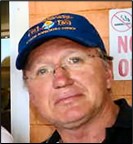
Allan George's Gems.
Contents
Reflecting on the past and future of the Air Force
The 31st March was an extraordinary day for the Royal Australian Air Force – 100 years of service to Australia.
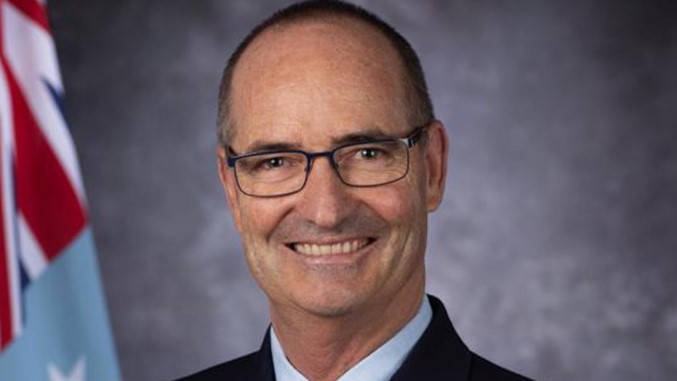
As we mark the end of our first century and the beginning of our second – it’s a time to reflect on the long journey Air Force has already taken – and what our future looks like.
More than 350,000 Australians have served in Air Force since 1921 with tragically 11,191 making the ultimate sacrifice in the service of their country. Air Force members are buried in cemeteries as far afield as the United Kingdom, Europe, North Africa, the Middle East, North America, South East Asia, Pacific Islands and across Australia. Of those lost, 3143 Air Force members have no known grave for their families to mourn beside.
Their commitment and sacrifice, and those of their families will never be forgotten.
The evolution of an Air Force founded on aircraft constructed of flimsy wood and Irish linen and operating from grass field runways, to one characterised by high tech capabilities that deliver effects not only in the air domain, but across all domains including space and cyber, is a tribute to generations of dedicated men and women and their remarkable ingenuity and resilience.
Through the decades, in conflict, peacekeeping, search and rescue, disaster relief and humanitarian assistance, Air Force developed a reputation within our nation and among our global partners for courage, perseverance and overcoming adversity, consistently delivering air power well above the weight of an Air Force our size. Every day we work closely with Navy, Army, defence industry, government agencies and our international partners – these relationships have always been important to us and will remain crucial as together we face the strategic challenges of an increasingly complex and competitive region.
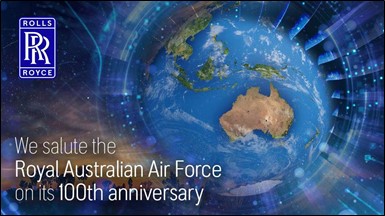
Our future force will look very different from the traditional air power of our past 100 years; because it must – the changing world demands it so. We are transforming into an Air Force that is based more than on aircraft constructed from composite materials that operate from asphalt runways, but one that is resilient and generates effects though the use of agile basing, redundant networks, smart logistics, leveraging off space systems and emerging cyber capabilities. However, the one constant that has endured over the past 100 years and will remain embodied in the future generations of Air Force is the incredible innovative skills and tenacity of our people.
Our workforce will not only be technically brilliant, their strategic acumen will be honed so that they will cognitively outmanoeuvre any potential adversaries. Our people understand we generate air and space power options to the Joint Force and understand air and space power effects in the context of land, sea, and cyber warfare domains – because we are One Defence. Today Air Force members and veterans will mark this important milestone in every State and Territory and across many locations overseas. I acknowledge and thank all members and veterans for their service. I encourage our current members to take an opportunity to pause and reflect on how they stand on the shoulders of the generations of Air Force personnel before them and recognise our responsibility we hold as the current custodians of our Air Force.
As we commence our second century, it is our duty to preserve this proud legacy and to maintain our enduring commitment to be ready whenever and wherever Australia needs us: Then. Now. Always.
Mel Hupfeld, Chief of Air Force
Mitzi’s husband Harry was late coming home again. Fed up, she wrote him a note saying, “I’ve had it! I’ve left you. Don’t bother coming after me.” Mitzi placed the note on his dresser, then hid under the bed to see his reaction. Some time later, Harry came home. She heard him rummage the fridge, walk up the stairs and enter their bedroom. She watched him go over to the dresser and pick up the note. After a few minutes, he wrote something on the back of her note. Then he called someone on his phone. “She finally did it. She left me… ‘Bout time, right? Darling, from now on it’s you and me. Put on that slinky dress and meet me at the Sheraton. It’s gonna be a night to remember and breakfast in bed! …I love you too. Can’t wait.” Harry grabbed his keys and trotted down the stairs. Mitzi heard his car drive off as she emerged from beneath the bed, furious and sobbing. Wiping her tears, she grabbed the note to see what he wrote.
“I saw your feet. We’re out of ice cream. Back in ten minutes.”
RAAF redefines role of C-27J Spartan.
On the 26 July 2021, the Air Force redefined the role of the C-27J Spartan fleet to focus primarily on Humanitarian Assistance Disaster Relief (HADR) operations.
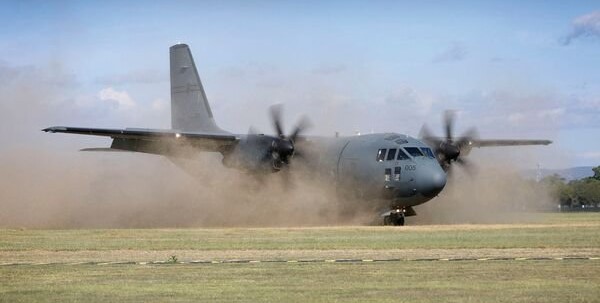
The Department of Defence (DoD) in Canberra said in a news release that the Spartans' new role will “enhance Australia's humanitarian and emergency response to natural disasters in Australia and our near region, regional engagement across the Indo-Pacific, including through ‘Pacific Step-Up', and the Australian Defence Force's military logistics and air-mobility capability”.
(That's a lot of words! - tb)
Both Chief of Air Force Air Marshal Mel Hupfeld and the head of Air Force Capability, Air Vice-Marshal Cath Roberts, praised the Spartan's performance, highlighting domestic bushfire relief and regional assistance, without giving any explanation for the amended role. The announcement follows the failure of the twin-turboprop aircraft to achieve full operational capability (FOC) in December 2020: a milestone that had already been delayed by four years. It also comes after the platform had been identified as a DoD “project of interest” in March 2020 following its failure to meet key performance, availability, and project schedule requirements.
The C-27J had previously been consistently described by the RAAF as a battlefield aircraft to bridge the intra-theatre gap between army helicopters such as the CH-47F Chinook and the RAAF's C-130J Hercules and C-17A Globemaster III transports.
Townsville.
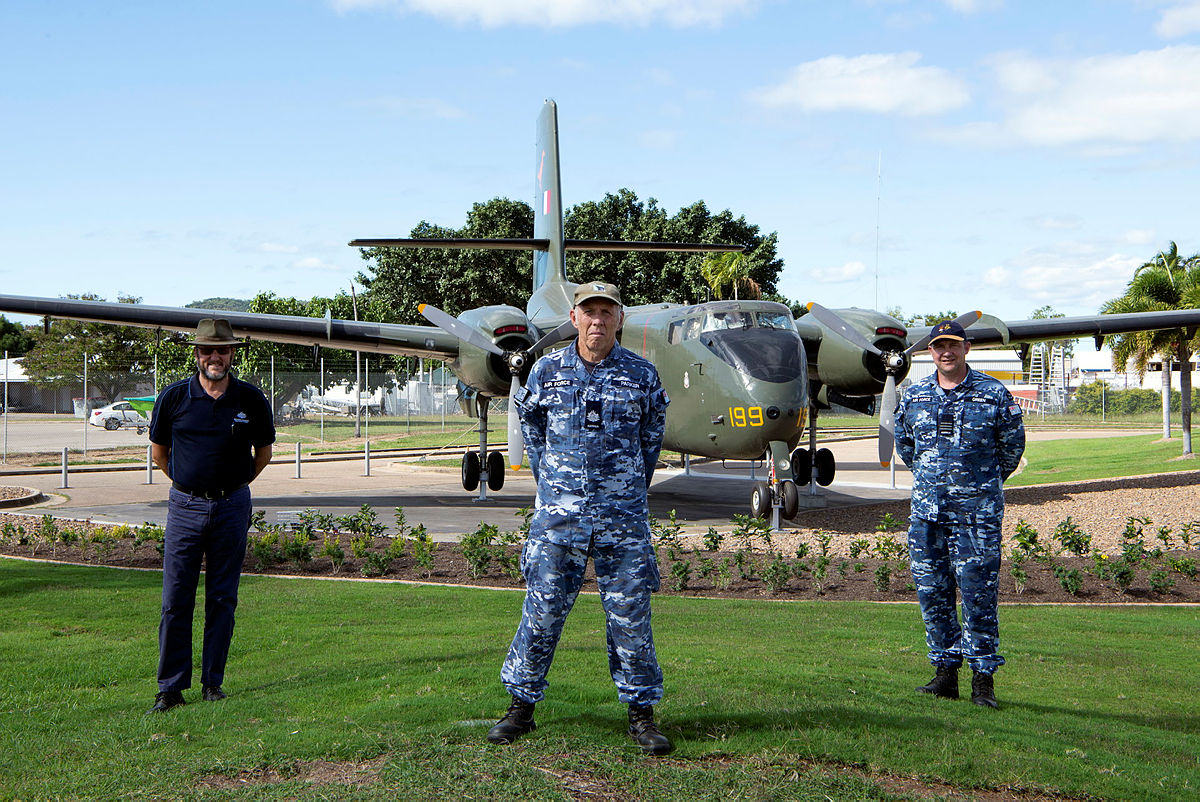
L-R: Base Manager Mick Harris, Warrant Officer Kevin Parker, SADFO (what we used to call OC) Wing Commander Mathew Green.
Back in June last year, after a 'pretty-up', Caribou A4-199 was put up on blocks at the front gate at Townsville. Reservists from the Static Display Aircraft Support Section (SDASS), an element of the RAAF’s History and Heritage Branch, completed the works during August and September 2019. The SDASS In conjunction with members of the RAAF Townsville Aviation Heritage Centre dismantled the Caribou and moved it in to Hangar 75 before applying an automotive ‘2-Pack’ style paint. The colour scheme is a Vietnam War era green with the Red Wallaby emblem on the tail. Caribou A4 -199 first flew with the Australian Air Force in 1964 and operated out of Townsville from 1975 until its retirement in 2009.
Below, how it looks at night. With the Spartan not living up to expectations, perhaps she should be fuelled up and put back on line.
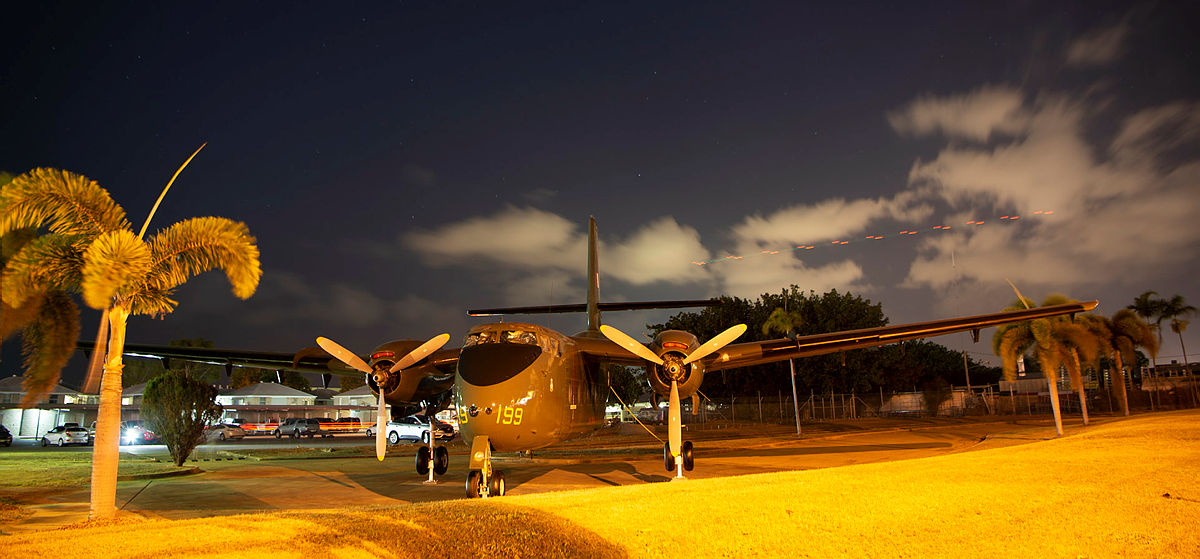
How to type with your voice in Windows 10.
If you’re tired of typing with a keyboard, entering text can be as easy as using your voice in Windows 10. The OS includes built-in speech recognition and dictation features.
Here’s how to set them up.
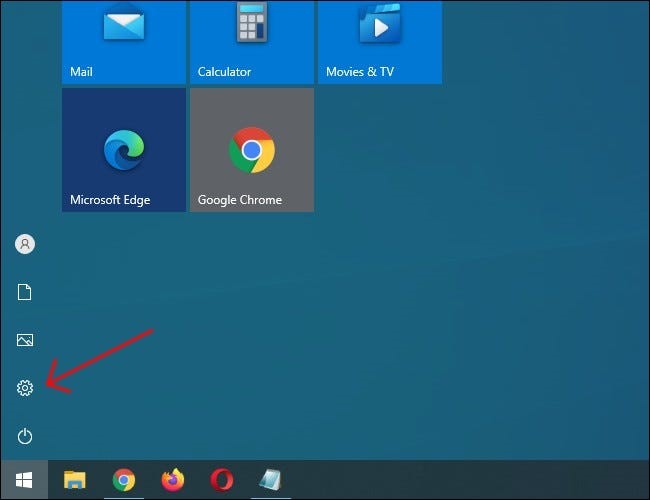
Microsoft’s dictation software is a useful way to write text quickly in Windows 10 using the Windows+h keyboard shortcut. But it may not already be enabled by default on your system, so you may have to make a quick trip to settings to enable it.
Begin by opening Windows Settings. To do so, open your Start menu and click the gear icon. You can also get there by pressing Windows+i on your keyboard.
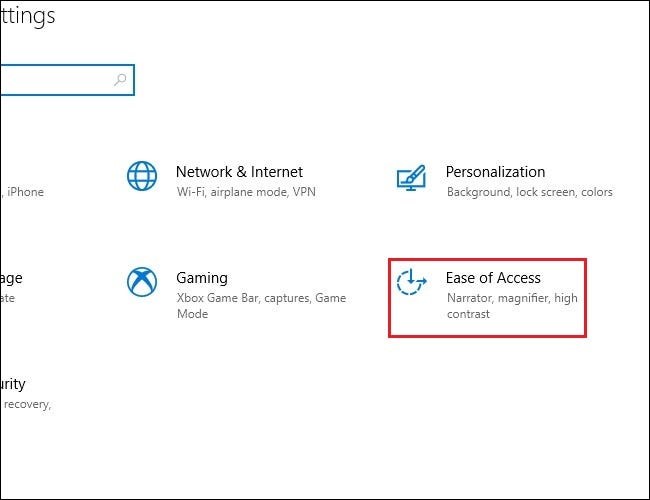
In Settings, click “Ease of Access.”
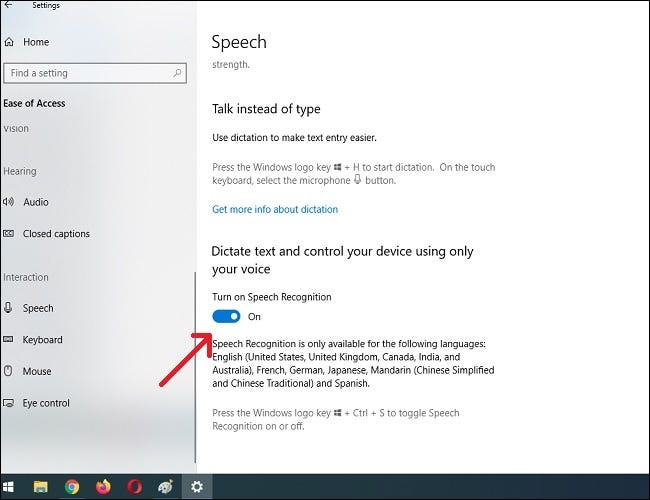
On the left pane, scroll down and click “Speech” in the sidebar. Under Speech settings, click the switch located below “Turn on Speech Recognition.” It should switch over to the “On” position.
Keep in mind speech recognition is only available in a few languages, including English, French, German, Spanish, Mandarin, and Japanese. To perform this action quickly, hit Windows+Ctrl+s to toggle speech recognition on or off instantly. (Windows = the Windows key)
When you toggle speech recognition on for the first time, you will need to set it up to recognize your voice.
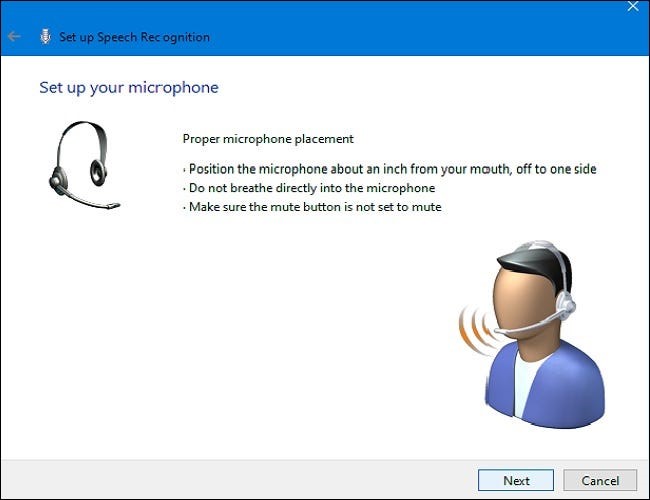
To perform the initial microphone setup, hook up either a headset microphone, desktop microphone, or other peripheral mics, then follow the on-screen prompt to choose and calibrate your microphone.
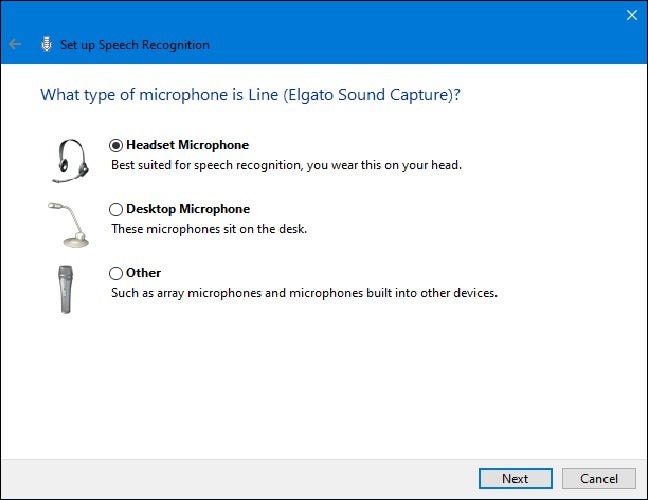
A headset mic seems to work the best.
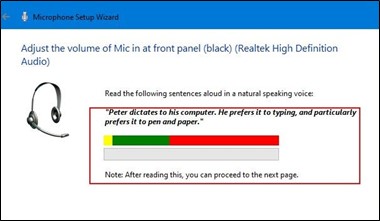
Once the headset is connected, say the on-screen phrase into your microphone, so the system will capture your voice and be able to recognize it while using the program.
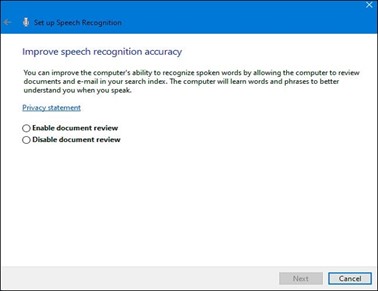
Finish up by selecting whether or not you want to allow the computer to review documents and email to help it improve speech recognition accuracy.
Once the setup is complete, you’re ready to begin typing with your voice!
Typing with your voice in Windows 10.

After you’ve successfully set up your microphone, you can start typing with your voice. The wizard will ask you to switch on Speech Recognition every time you start up the computer. Answer appropriately according to your preferences and you’re finally ready to start typing with your voice.
If you want to use dictation, select a text field and call up the dictation bar with Windows+h. We’ll use a blank text document as an example. After hitting Windows+h, the dictation bar will pop up at the top of the screen:
Dictation will automatically turn on and prompt you to speak once you call up the dictation bar. If it doesn’t, simply click the microphone icon to enable it. Begin speaking into your microphone. Speak in complete, deliberate sentences. You can say whatever you like, and you’ll see it typed on the screen as you go along. Here are some tips while you dictate:
|
Punctuation: |
To add punctuation, say the name of the punctuation mark you want to use as you work. For example, say “period” to place a period at the end of a sentence, or say “comma,” “E-M dash,” “semicolon,” “exclamation point,” or “question mark” to add those punctuation makes to your document.
|
|
Parentheses: |
For parentheses, say “open parentheses” to start a parenthetical phrase and “close parenthesis” to end the phrase.
|
|
Numerical Values: |
Say “numerical” followed by a number to type out the numerical values.
|
|
Navigating Paragraphs: |
To move to the next paragraph, say “next line” or “next paragraph.”
|
|
Deleting Text: |
To delete words, say “delete,” followed by the word you want to delete. You can also say “delete previous sentence” to get rid of an entire sentence you no longer wish to keep in the document.
|
|
Selecting: |
To select a word, say “select,” followed by the word you wish to highlight.
|
|
Move to Beginning or End of Sentence. |
If you want to go to the beginning or end of a sentence, say “go to start of the sentence” or “go to the end of the sentence. This also works for navigating paragraphs and the start or end of a document.
|
|
Stop dictating: |
Say, “stop dictating.”
|
Remember to speak clearly and avoid speaking too fast, as it can mess with your writing flow as the software tries to catch up your pace (When talking fast, you might experience some input lag until you slow down a bit).

To turn it back on, or if it cuts out unexpectedly, click the microphone on the dictation bar to re-enable it:
Dictation will allow you to use your voice to write things faster and easier than if you were typing them, and it’s pretty fun too.
How to Disable Dictation and Speech Recognition in Windows 10.
Dictation software is ideal for a number of uses, but you may decide to disable it at some point. If you accidentally enable dictation or simply no longer wish to use it, disabling it is fairly straightforward. All you need to do is hit Windows+h again to toggle it off.
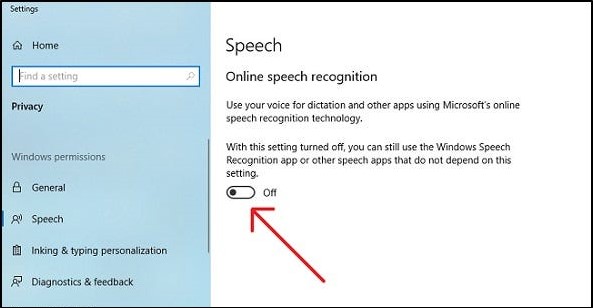
If you want to shut off speech recognition entirely, so you don’t accidentally start dictation, disable it by using Windows+Ctrl+s. This will completely disable speech recognition.
Alternatively, head back to Windows Settings. Click “Ease of Access” again, find “Speech,” and flip the switch beneath the words “Turn on Speech Recognition” to the “off” position.
Remember, you can always turn speech recognition back on and use the dictation feature any time with Windows+H.
The older you get the more you appreciate cancelled plans, early nights, thunderstorms and alcohol that is on sale.
Leading causes of death.
There were 169,301 registered and received deaths in Australia in 2019, an increase of 6.8% (10,808) from 2018. For deaths registered and received in 2019:
52.2% of deaths were male (88,346) and 47.8% of deaths were female (80,955) which is a little bit disproportionate as there were 12.6m males (49.6%) and 12.79m females (50.4%) in Australia in 2019. The median age at death was 81.7 years (78.8 for males, 84.8 for females).
The top five leading causes accounted for more than one-third of all registered deaths.
Identifying and comparing leading causes of death in populations is useful for tracking changes in patterns of mortality and identifying emerging trends.
Key statistics for 2019:
The leading cause of death was Ischaemic heart disease.
-
Dementia, including Alzheimer's disease was the second leading cause of death and had the highest median age at death at 89.1 (equal with cardiac arrhythmias).
-
Cerebrovascular diseases, Cancer of the trachea, bronchus and lung and Chronic lower respiratory diseases round out the top five leading causes.
-
Diabetes (E10 – E14) ranked 7th as the main cause of death.
-
Influenza and pneumonia was the 9th leading cause. Influenza deaths are linked to the severity of flu seasons which can drive changes in ranking each year.
-
Intentional self-harm was the 13th leading cause of death, with the lowest median age at death at 43.9.
In the ten years from 2010 to 2019:
-
Deaths from Ischaemic heart diseases and Cerebrovascular diseases decreased by 16.0% and 11.7% respectively.
-
Deaths from Dementia, including Alzheimer's disease increased by an alarming 66.8% (6,013 deaths).
-
Deaths from Chronic lower respiratory diseases increased by 36.6% (2,243 deaths).
-
Increases in numbers of deaths were recorded for all other leading causes in the top 20.
Are email addresses case sensitive?’
If, like a lot of other people in this world, you have a Gmail email address, you don’t have to worry about upper and lower case issues: Gmail addresses are not case sensitive and dots within the username portion of your email address are fine – even if they’re added between each letter. So even if those discrepancies slip in when others are attempting to contact you, those emails should still be delivered.
Let’s say, for example, that you sign up for the Gmail address “AG47@gmail.com”. If someone sends an email to any of the following addresses AG.47@gmail.com. A.G.47@gmail.com, a.G47@gmail.com, ag47@gmail.com, or AG47@gMail.com you will still get it, however Gmail will not let you use two .. in a row.
Generally speaking, this is true for all other email servers too but be careful as some of the older ones might balk if you mix upper and lower case letters in the address. But even though a mixture is now pretty well accepted, that doesn’t make using them a good idea. Having a mixture of capitals and lowercase can make your email address difficult to read.
Most email servers recognize and allow the special characters in this lineup.
! # $ % & ‘ * + – = ^ _ {} ~
However, Gmail doesn’t allow characters from this set.
& = _ ‘ – + ,
Gmail also doesn’t allow greater than and less than brackets (< >). But!! and there's always a BUT, if you're using Outlook as your email server and you've set a rule to place all emails sent to AG47@gmail.com into a certain folder, when it receives one of the alternatives (as above) although it will process that email OK, it won't place it in your designated folder. You'll either find it in your INBOX or even in your TRASH folder.
Don't believe me?? Try it!
De Havilland – Australia.
Once upon a time we used to build aeroplanes here in Australia, sadly, we don’t anymore. Actually, when you think about it, we don’t build a lot of things in Australia any more, these days we’ve become more of service related country – we get other people to do stuff that we used to do ourselves, like mow the lawn, wash the car, paint the house, walk the dog, look after our kids.
Not so long ago we built Holdens, Falcons, Valiants and Datsuns and refrigerators and washing machines and lots and lots of other stuff – even aeroplanes, but not any more.
One of those aeroplane builders way back was De Havilland which produced a booklet showing the different types of aircraft they did build. You can get a copy HERE.
The change in air travel.
In the not too distant future, the tube with wings aeroplane could disappear as once did steam locomotives. Those of us with a few years under the belt have seen many advances in technology, from 3ft high wooden cabinet radio receivers to multi-band AM/FM radios that can fit on your thumb-nail, from death trap cars with 30HP engines and 3 speed crash gear boxes to the temperature controlled super safe self drive electric machines we have today, from everyday air travel in the DC3 to the super sophisticated Boeing 787s that now rule the skies.
The only constant in our lives is change.
Aircraft manufacturers have always worked on improving the aeroplane – to make it more efficient and less costly to run. The cost per bum on seat to run an aeroplane has decreased sharply over the years, where once air travel was a novelty, a privilege and people frocked up, today going from A to B in the air can be cheaper than driving. It’s no longer a novelty, today you would be hard pressed to find someone who hasn’t flown at one time in their lives. People board aircraft dressed in shorts and thongs, it’s just a means of travel, it’s common and the novelty has gone out of it.
But the aeroplane as it is today, a long tube with wings, has just about reached its maximum level of efficiency. Pistons gave way to jets, turbo jets gave way to turbo fans, 4 engine aircraft changed to 3 engines and now 2, there isn’t much more they can do engine wise, but they can improve the tube.
Manufacturers have been playing with the all wing concept for many years but it wasn’t until the Northrop Grumman B2 Spirit bomber, which first flew in 1989, that they got it right. Hitler’s Germany had a go at it but didn’t have the electronic smarts to control it. Northrop tried earlier too in the late 1940s with the YB-35 then the YB49, but he didn’t have it right either – now they have.
The next big change in air travel will surely be a flying wing in which will sit the pax. The tube will gradually disappear as the wing will be cheaper to fly, will carry more, be faster and cheaper to maintain.
Real Engineering has produced an interesting video on the wing concept – you can see it HERE.
And for those with a bit of nostalgia in them – THIS this will make you smile.
100 Squadron RAAF.
The RAAF has decided to formalise its Museums by re-forming 100 Squadron as the Air Force’s Heritage Squadron. It will operate from two locations, Point Cook and Temora in NSW.
First established during the Second World War in February 1942 at Richmond, 100 Squadron was an Air Force bomber and maritime patrol squadron, trained on Australian-built Bristol Beauforts. It conducted several successful missions throughout the war, taking part in the famous Battle of the Bismarck Sea in March 1943, and eventually disbanding in New Guinea on 19 August 1946.
100 Squadron will fly a number of aircraft from the current heritage fleet from Point Cook and Temora. Temora has an extensive aviation history dating back to the Second World War where pilots trained at RAAF’s No. 10 Elementary Flying Training School. The training school closed after the Second World War on 12 March 1946, but since then Temora has maintained a strong aviation focus, which will now include being part of the rejuvenated No. 100 Squadron.
Temora Historic Flight will build on to the Riverina’s lengthy contribution to the RAAF, which includes RAAF Base Wagga and the former 5 Service Flying Training School at Uranquinty. The Temora Aviation Museum has played a special role in preserving RAAF history since 2000 by flying and displaying some iconic warplanes, such as the Spitfire.
The new Air Force Heritage Squadron headquarters at Point Cook would provide a historical connection to the community.
Point Cook based aircraft.
|
• Mustang VH-SVU A68-170 • CT4A VH-NZP A19-077 • Sopwith Pup VH-PSP • Harvard VH-HVD NZ1075 • Sopwith Snipe VH-SNP |
• RE8 VH-OTF RE8-1 0003 • Winjeel VH-FTS A85-439 • Tiger Moth VH-AWA A17-692 • P-40 A29-90
|
Temora based aircraft.
|
• Canberra VH-ZSQ • Cessna A37 VH-XVA • Spitfire Mk.VIII. VH-HET • DH Vampire VH-VAM • Lockheed Hudson VH-KOY • CAC Wirraway VH-BFF |
• CAC Sabre VH-IPN • CAC Boomerang VH-MHR • Ryan STM VH-RSY • Meteor F8 VH-MBX • Spitfire Mk.XVI VH-XVI • Tiger Moth VH-UVZ |
Canberra bomber soars again.
A roar broke the silence as the 100 Squadron Temora historic flight Canberra bomber taxied to the threshold on June 28 before taking off.
This was the maiden flight of the restored English Electric Canberra bomber TT.18 after an extensive engineering effort undertaken by the Temora Aviation Museum to return the aircraft to airworthy condition more than 10 years after it last flew. The project to restore the former Royal Air Force aircraft was first announced in 2017 by museum president and founder David Lowy before the aircraft was donated to the Air Force in July 2019. It was one of 11 historic warbirds to be donated.
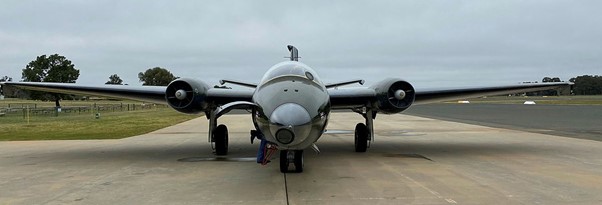
Commanding Officer of No. 100 Squadron Wing Commander Philip Beanland said the aircraft’s return to flight was a phenomenal achievement and a testament to the skilled members of the Temora Aviation Museum and No. 100 Squadron.
There have been many people involved in contributing to this aircraft
being able to take off and they should all be immensely proud of their
efforts. 100 Squadron Temora historic flight pilot and aircraft captain
Flight Lieutenant Darren Crabb said the Canberra was a pleasure to fly
and handled exactly as expected. Even though it has been 10 years since
the Canberra last flew, it performed beautifully, to be the first pilot
to fly the Canberra f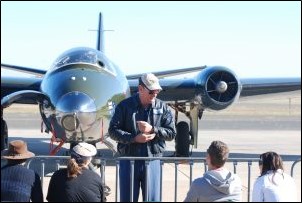 ollowing the restoration is a great privilege and
will long be a career highlight. The aircraft is a tribute to an over
century-old relationship between the Royal Air Force and the Royal
Australian Air Force.
ollowing the restoration is a great privilege and
will long be a career highlight. The aircraft is a tribute to an over
century-old relationship between the Royal Air Force and the Royal
Australian Air Force.
Right: Air Commodore (Rtd) Rod Luke talking with members of the public following his final flight in the Temora Aviation Museum Canberra bomber in 2010.
Although the restored aircraft was not operated by the Royal Australian Air Force while in service, it was repainted by the Temora Aviation Museum to represent the aircraft flown by 2 Squadron during the Vietnam conflict.
The Canberra entered service with the RAAF when a British-built Canberra B2s arrived at No. 82 Wing in August 1951 followed by a second in May 1952. Forty-eight aircraft were then manufactured in Australia by the Government Aircraft Factory and were operated by Nos. 1, 2 and 6 Squadrons. The Canberra bomber played a key role in Australia’s contribution to the Vietnam War, where 2 Squadron operated for four years as part of the US Air Force’s 35th Tactical Fighter Wing. 2 Squadron operated the Canberra bombers until 1982, which was well past their planned retirement date and their last flight was a four-ship farewell flypast over Brisbane and surrounding areas.
The aluminium can.
We’re all familiar with the aluminium drinking can, it’s been around now for quite a while but do you know how it’s made – it’s fascinating. See the video below.
The Cold War.
The Cold War was a period of geopolitical tension between the United
States and the Soviet Union and their respective allies, the Western
Bloc and the Eastern Bloc, which began following World War II.
Historians do not fully agree on its starting and ending points, but the
period is generally considered to span the 1947 Truman Doctrine (12
March 1947) to the 1991 Dissolution of the Soviet Union (26 December
1991). The term cold war is used because there was no large-scale
fighting directly between the two superpowers, but they each supported
major regional conflicts known as proxy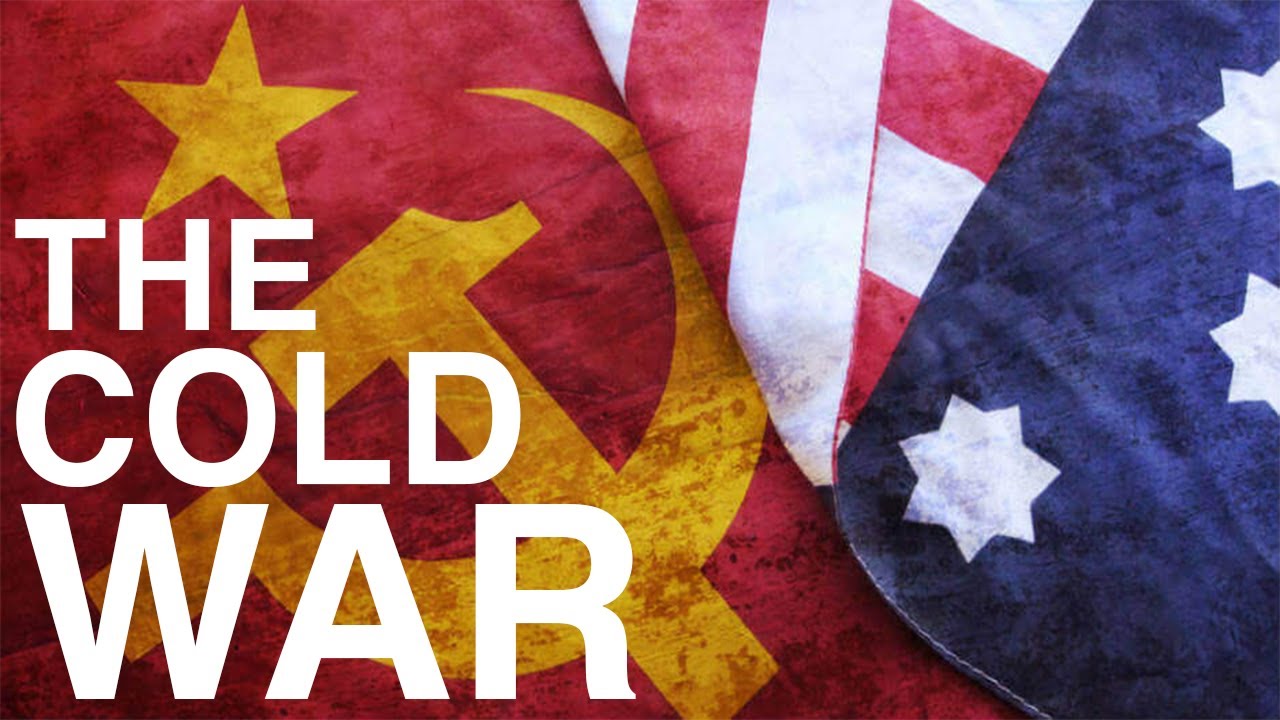 wars. The conflict was based
around the ideological and geopolitical struggle for global influence by
these two superpowers, following their temporary alliance and victory
against Nazi Germany in 1945. Aside from the nuclear arsenal development
and conventional military deployment, the struggle for dominance was
expressed via indirect means such as psychological warfare, propaganda
campaigns, espionage, far-reaching embargoes, rivalry at sports events
and technological competitions such as the Space Race.
wars. The conflict was based
around the ideological and geopolitical struggle for global influence by
these two superpowers, following their temporary alliance and victory
against Nazi Germany in 1945. Aside from the nuclear arsenal development
and conventional military deployment, the struggle for dominance was
expressed via indirect means such as psychological warfare, propaganda
campaigns, espionage, far-reaching embargoes, rivalry at sports events
and technological competitions such as the Space Race.
The Western Bloc was led by the United States as well as the other First World nations of the Western Bloc that were generally liberal democratic but tied to a network of the authoritarian states, most of which were their former colonies. The Eastern Bloc was led by the Soviet Union and its Communist Party, which had an influence across the Second World. The US government supported right-wing governments and uprisings across the world, while the Soviet government funded communist parties and revolutions around the world. As nearly all the colonial states achieved independence in the period 1945–1960, they became Third World battlefields in the Cold War.
The first phase of the Cold War began shortly after the end of the Second World War in 1945. The United States created the NATO military alliance in 1949 in the apprehension of a Soviet attack and termed their global policy against Soviet influence containment. The Soviet Union formed the Warsaw Pact in 1955 in response to NATO. Major crises of this phase included the 1948–49 Berlin Blockade, the 1927–1949 Chinese Civil War, the 1950–1953 Korean War, the 1956 Hungarian Revolution, the 1956 Suez Crisis, the Berlin Crisis of 1961 and the 1962 Cuban Missile Crisis. The US and the USSR competed for influence in Latin America, the Middle East, and the decolonizing states of Africa and Asia.
Following the Cuban Missile Crisis, a new phase began that saw the Sino-Soviet split between China and the Soviet Union complicate relations within the Communist sphere, while France, a Western Bloc state, began to demand greater autonomy of action. The USSR invaded Czechoslovakia to suppress the 1968 Prague Spring, while the US experienced internal turmoil from the civil rights movement and opposition to the Vietnam War. In the 1960s–70s, an international peace movement took root among citizens around the world. Movements against nuclear arms testing and for nuclear disarmament took place, with large anti-war protests. By the 1970s, both sides had started making allowances for peace and security, ushering in a period of détente that saw the Strategic Arms Limitation Talks and the US opening relations with the People's Republic of China as a strategic counterweight to the USSR. A number of self-proclaimed Marxist regimes were formed in the second half of the 1970s in the Third World, including Angola, Mozambique, Ethiopia, Cambodia, Afghanistan and Nicaragua.
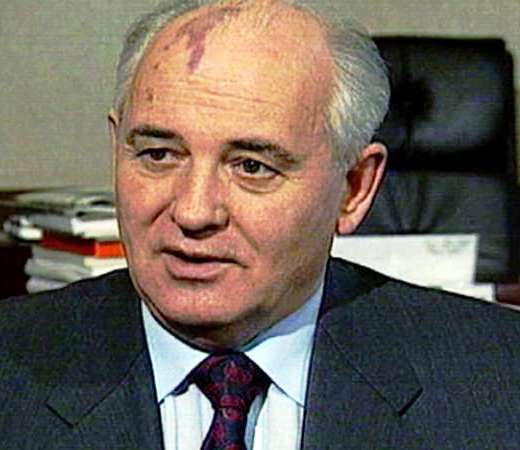
Détente collapsed at the end of the decade with the beginning of the Soviet–Afghan War in 1979. The early 1980s was another period of elevated tension. The United States increased diplomatic, military, and economic pressures on the Soviet Union, at a time when it was already suffering from economic stagnation. In the mid-1980s, the new Soviet leader Mikhail Gorbachev introduced the liberalizing reforms of glasnost ("openness", c. 1985) and perestroika ("reorganization", 1987) and ended Soviet involvement in Afghanistan. Pressures for national sovereignty grew stronger in Eastern Europe, and Gorbachev refused to militarily support their governments any longer.
In 1989, the fall of the Iron Curtain after the Pan-European Picnic and a peaceful wave of revolutions (with the exception of Romania and Afghanistan) overthrew almost all communist governments of the Eastern Bloc. The Communist Party of the Soviet Union itself lost control in the Soviet Union and was banned following an abortive coup attempt in August 1991. This in turn led to the formal dissolution of the USSR in December 1991, the declaration of independence of its constituent republics and the collapse of communist governments across much of Africa and Asia. The United States was left as the world's only superpower.
The Cold War and its events have left a significant legacy. It is often referred to in popular culture, especially with themes of espionage and the threat of nuclear warfare.
There is an excellent movie HERE which is definitely worth watching.
Butterworth radar unit placed on alert. 3 September 1964.
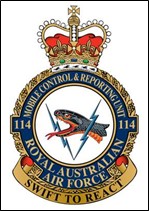
All leave in No 114 Mobile Control and Reporting Unit (114MCRU) at RAAF Base Butterworth was cancelled on this day and the unit began a 24-hour, seven-days-a-week operation. The previous day, about 100 Indonesian paratroops had been airdropped into northern Johore, signalling a disturbing escalation in Indonesia’s policy of confrontation with the newly-created Federation of Malaysia.
As a precaution against possible air raids, the operations room and the unit’s power station were sandbagged. Small arms and ammunition were also issued to technical and operations personnel, as a self-defence measure against possible attacks by saboteurs and armed guards and area patrols were instigated. A month later, a detachment of 114MCRU was dispatched to Kampong Changkat, south of Butterworth, to operate an Army Mk 7 light anti-aircraft ‘gap filler’ radar, but by the following month the alarm created by the Indonesian landings had largely dissipated.
Fake news
There’s a video roaring around the interweb which says “China doesn't let the rest of the world know what happens in China. The Gorges Dam in China was opened 2nd August 2021 due to heavy overflowing see what happened next”.
It’s rubbish! The video (see HERE) was taken in 2011 and is the result of the Tsunami that hit Japan all those years ago.
Wouldn’t you just love to do THIS?
38 Sqn, Detachment A.
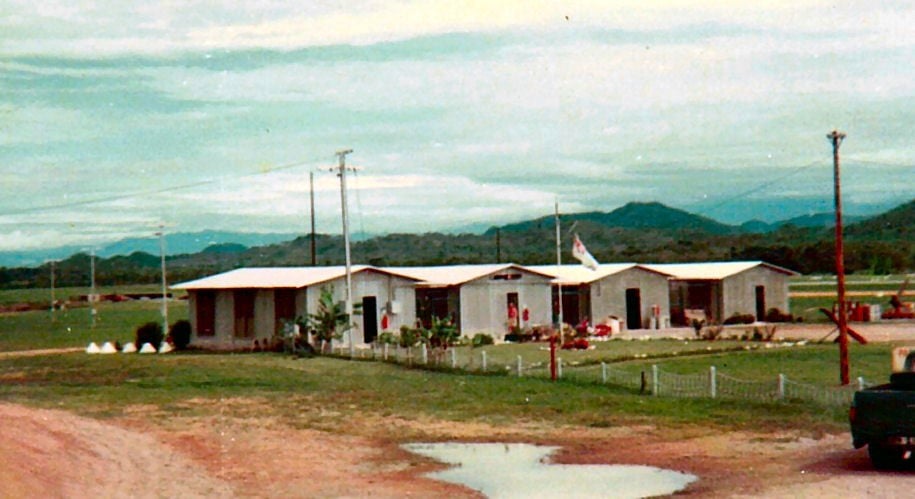

The building on the right was initially used by the Army's 16 ALA when they flew their Cessna 180s
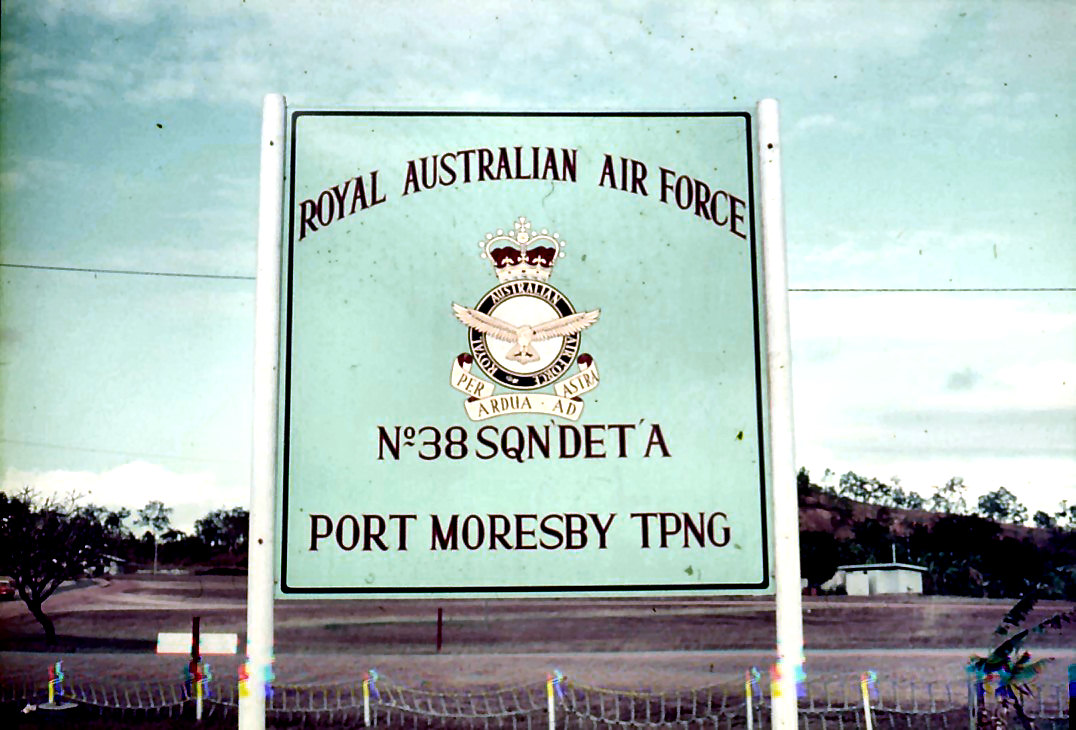
No. 38 Squadron was equipped with new de Havilland Canada DHC-4 Caribou tactical transport aircraft during 1964. In January 1964 the unit's commanding officer, five other pilots and three navigators undertook conversion training on the type in Canada. At the completion of this course the personnel flew the RAAF's first three Caribous from Toronto to RAAF Base Richmond between 17 March and 22 April. The process of fully converting No. 38 Squadron to Caribous was delayed by the government's decision to deploy several of the aircraft to Vietnam; at the time this decision was made, in June 1964, the squadron had received six of its planned allocation of nine aircraft, and the next batch of three aircraft was sent directly to Vietnam.
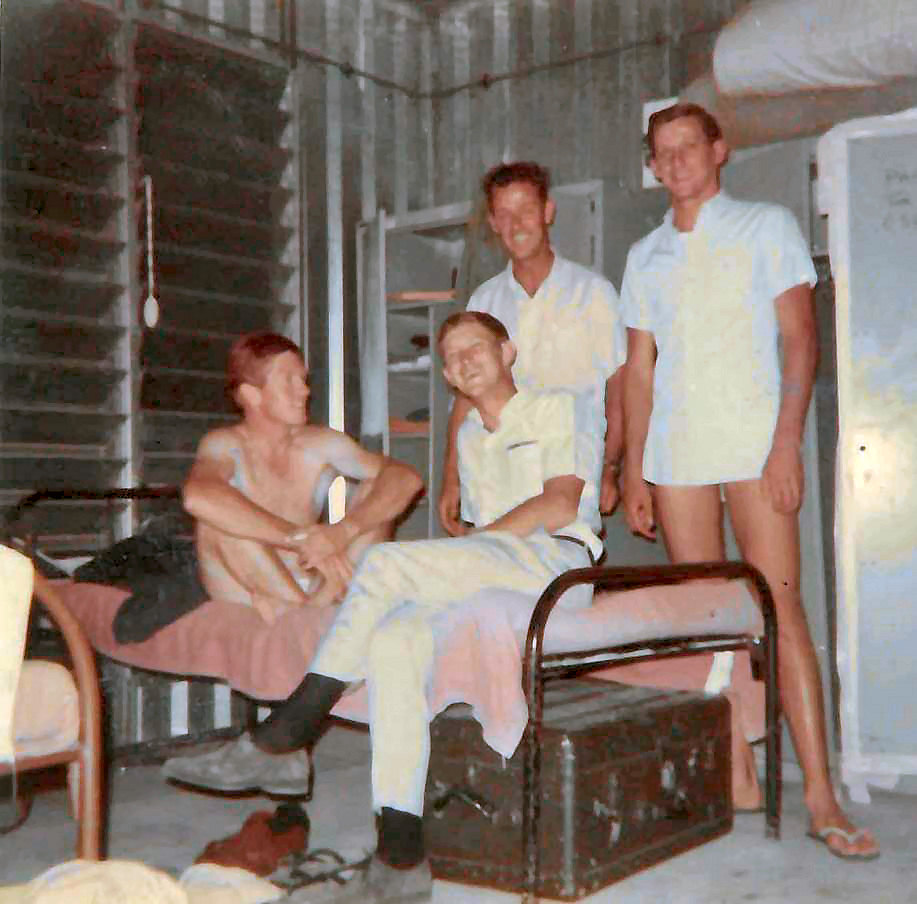
After receiving its Caribous, 38 Squadron's main role was to train aircrews for operational service with the RAAF Transport Flight Vietnam (later redesignated No. 35 Squadron). On 1 July 1964, one of the squadron's Caribous suffered severe damage when it made a crash landing at HMAS Albatross; this aircraft was subsequently written off and its fuselage used for training purposes by the Army's 1st Commando Regiment. The squadron became an independent unit under Headquarters RAAF Base Richmond in August that year, following the disbandment of No. 86 Wing. On 13 October 1965, Detachment A of 38 Squadron began operations from Port Moresby in PNG equipped with two Caribous. One of the detachment's tasks was to give Caribou pilots experience in tropical and mountainous conditions, and all aircraft captains were required to complete at least one two-month deployment to Port Moresby before serving with No. 35 Squadron in Vietnam.
Standing: Len Pridham, Dick Salter,
On bed: Graham “Blue” Silk, Jerry “The Flange” Lange.
Det A, as it was called, was also a good time for the Sqn’s maintenance people to experience working in tropical conditions prior to being posted to Vietnam. For a bloke coming from Tasmania, or some other cold climate, Moresby was an eye-opener, the constant heat and regular afternoon thunderstorms were quite different working conditions to those experienced at Richmond with its frosts and fogs. As well as working in the tropical heat, the blokes were accommodated at Murray Barracks, which was established in the Boroko area, about half way between the airport and the city itself, and living conditions were quite spartan – but being young and healthy, no-one cared.
Sometimes the Caribou had to be flown over to Duago Island for a "compass swing", about a 10 min chock to chock flight, and non-instrument bods would go along to ensure the aircraft was secure on that uninhabited island. Once security was established, non-instrument blokes would have to spend the rest of the day on the pristine beaches with one or two eskys filled with some of the good sustenance stuff.
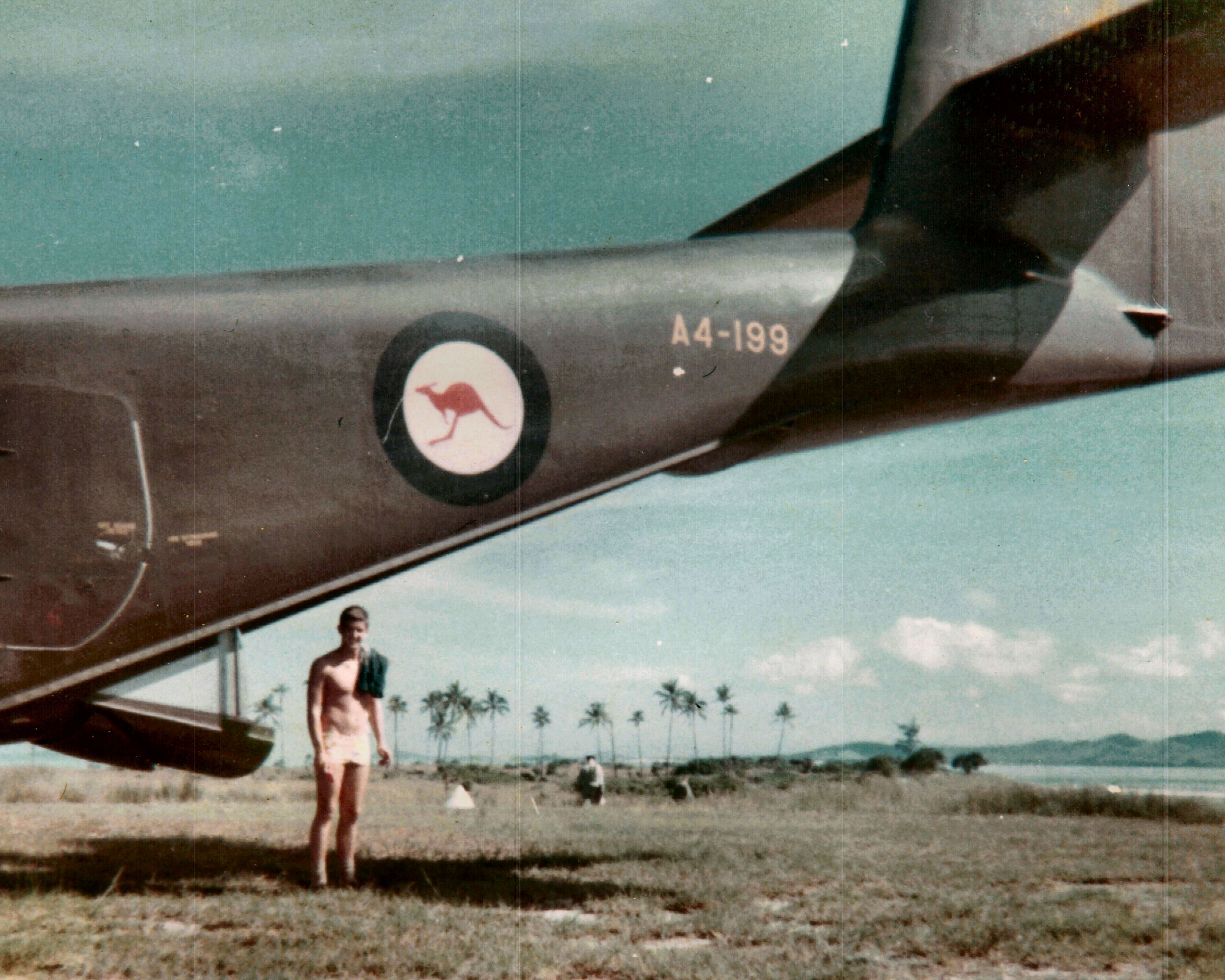
John Boyne, elec,
John had to accompany the trip to Duago Island just in case there was a severe elect problem, like a bulb out and radio had to go too - someone had to wind up the wander lead on the pre-flight.
But it wasn’t all hard work. After the job was done there were always times for some relaxing pursuits.
The boss at the time, the late Ron Raymond, knew his counterpart in the Army and whenever Army wanted to test sail one of its landing craft, after a service, Ron would offer his blokes as ballast so Army could give the vessel a good workout. Army would leave Moresby Harbour early morning on a Sunday and cruise out to Duago Island then stop a while to allow the engine to cool down then head back home again later in the day. Having undergone hours of survival training, the RAAF blokes would bring along a metal trunk filled with some of SP’s finest, topped with copies quantities of ice, just in case there was a malfunction. And as there were a couple of old parachutes hanging around, they would be packed too just in case they were stranded and needed shelter.
.jpg)
Boss Ron was a great believer in maintaining good relations with the Moresby civvy population, especially the female side, and often he would invite several to the workshop area for an Ozzie barby and a few quite ales. Of course, this was always done in the PM hours after all work had been completed.
.jpg)
Here “Blue” Silk is showing two of the ladies the workings of the Tacan inverter.
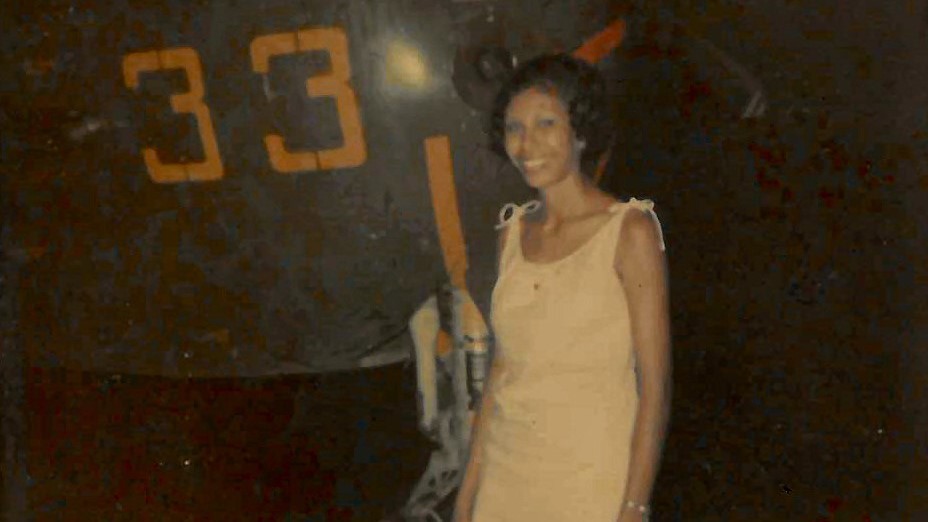
While Sue, one of the lovely ladies from Moresby, was being shown the golden rivet in the Caribou by one of the very helpful lads.
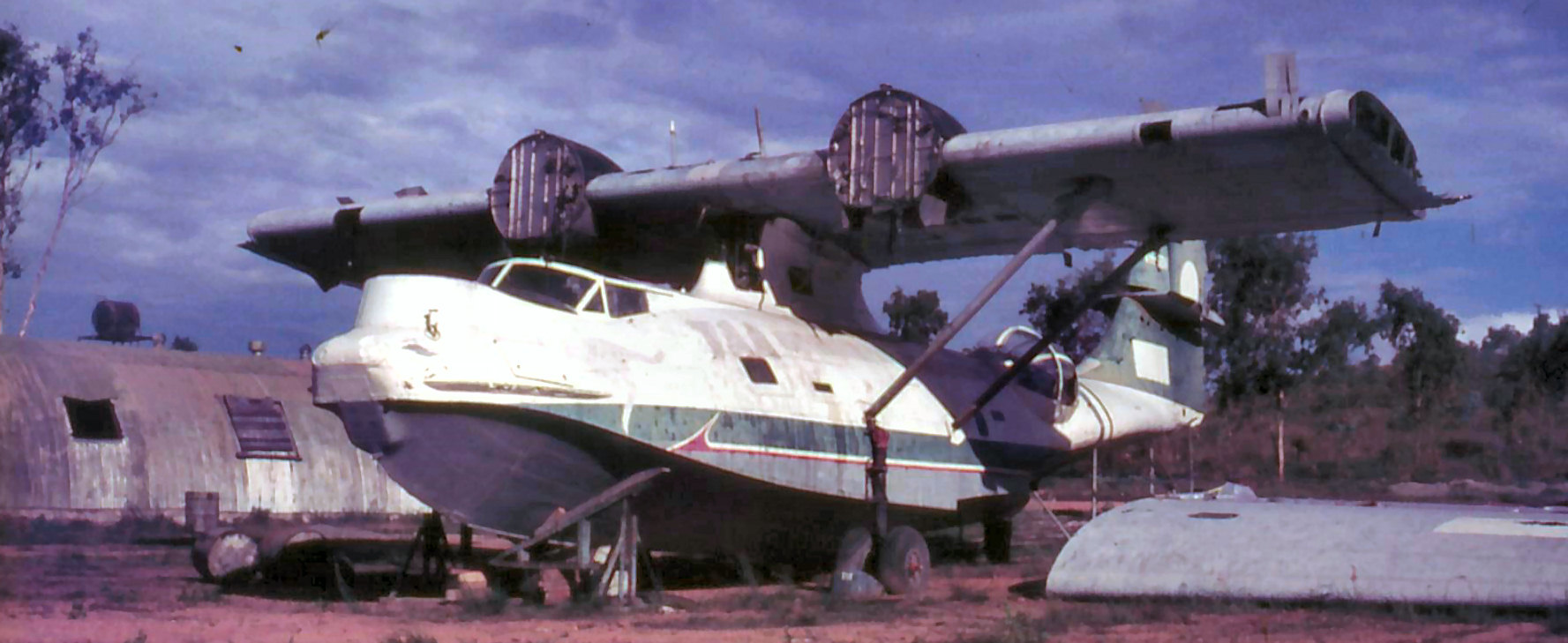
This Catalina, which has seen better days, was parked next to the Aero Club.
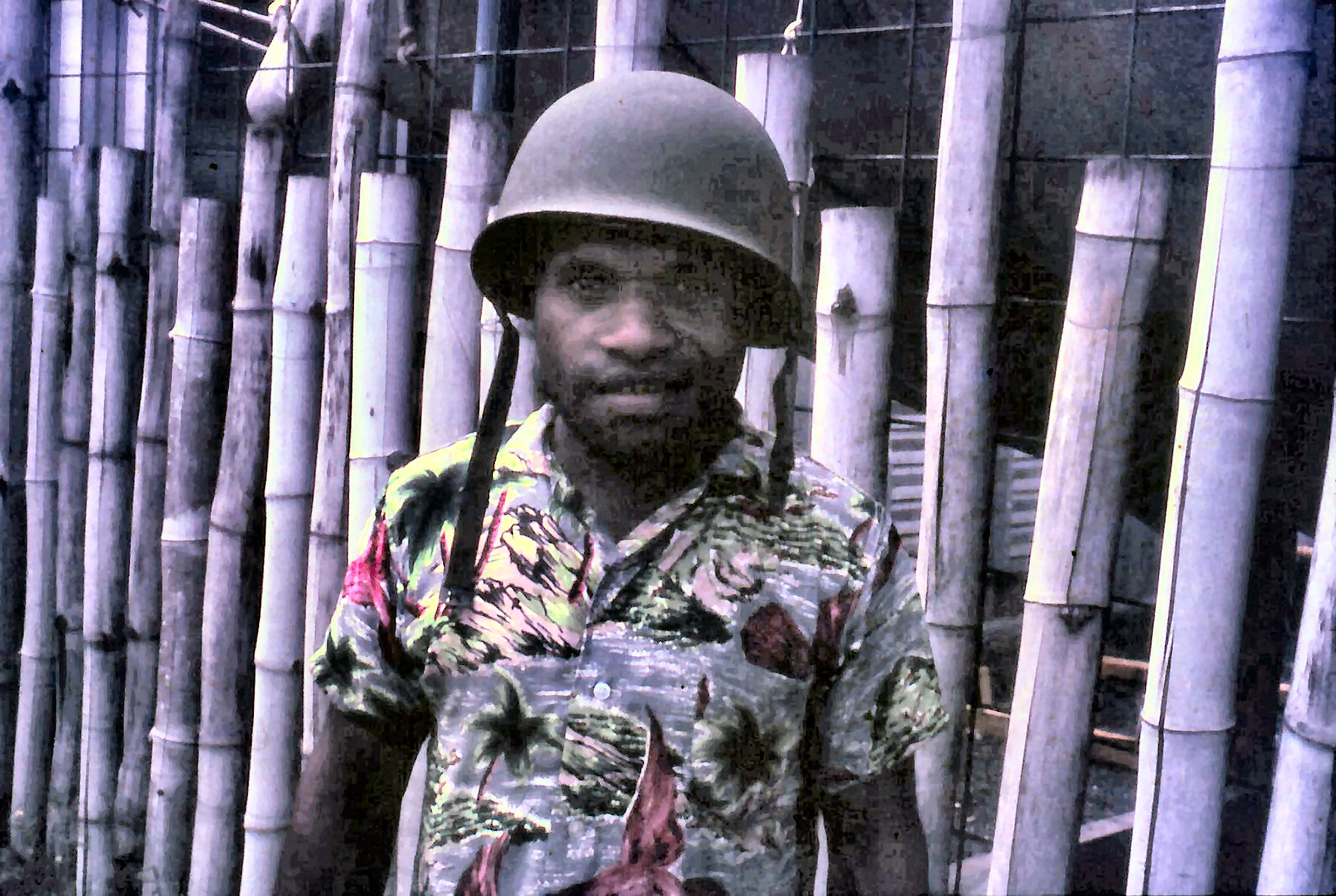
Lorokie, the Sqn's little helper. Lorokie never wore shoes yet some days when the Caribou had sat under the Moresby sun for some hours, when you were up on the wing refuelling, you could feel the heat through your thick soled T-boots, yet Lorokie could walk around up there barefooted no problem.
He was also a great little asset to have on your side when playing darts. He wasn't all that sure of the numbers so when ever you wanted a double 6 or any other number you'd just go up to the dartboard and point to where you wanted the dart. He'd whack it in every time, most times right up to the feathers.
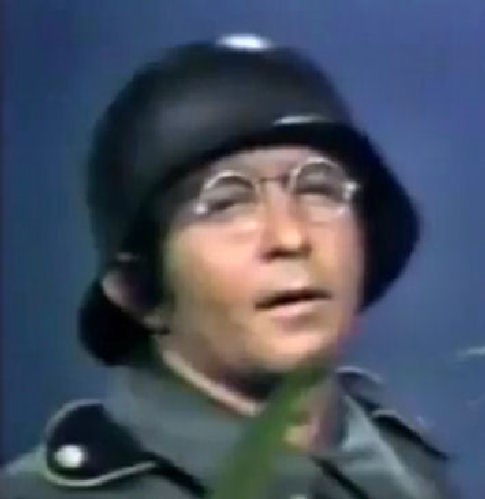
Velly Intelesting - but stoopid!!
Back Go to page: 1 2 3 4 5 6 7 8 9 10 11 12 13 14 15 16 17 18 19 20 Forward